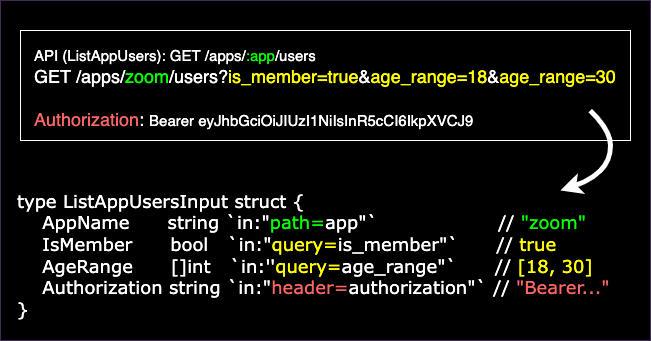Decode HTTP Query Params into a Struct in Go
Use httpin package to decode HTTP request params into a struct in Go.

Many people use net/http package directly in Go to deal with HTTP requests, including reading URL parameters, HTTP headers, and the request body. It's straightforward and efficient, though. We can still get bored writing so much tedious code for just reading and parsing the URL params. Especially when we were maintaining a service with hundres of APIs.
Let's see a piece of code for dealing with HTTP requests by using net/http package:
// GET /v1/users?page=1&per_page=20&is_member=true
func ListUsers(rw http.ResponseWriter, r *http.Request) {
page, err := strconv.ParseInt(r.FormValue("page"), 10, 64)
if err != nil {
// Invalid parameter: page.
return
}
perPage, err := strconv.ParseInt(r.FormValue("per_page"), 10, 64)
if err != nil {
// Invalid parameter: per_page.
return
}
isMember, err := strconv.ParseBool(r.FormValue("is_member"))
if err != nil {
// Invalid parameter: is_member.
return
}
// Read database and return the user list.
}It's okay if there are only a few (usually less than 3) parameters to be parsed. But what if more? Both the number of lots of local variables and the writing of statements of parsing string URL params to target types can kill us. Someone even spreads these statements all over in an API handler. 🤒
For such cases, what can we do to save a clean and tidy code base?
Using ggicci/httpin
httpin - 🍡HTTP Input for Go - Decode an HTTP request into a custom struct
ggicci/httpin is an awesome package which helps you easily decoding HTTP reqeusts from:
- Query string (URL parameters), e.g.
?name=john&is_member=true - Headers, e.g.
Authorization: xxx - Form data, e.g.
login=john&password=***** - JSON/XML body, e.g.
POST {"name": "john", "is_member": true} - Path variables, e.g.
/users/{username} - File uploads
You don't need to write parsing code for any parameter by yourself. With httpin, you only care about the definition of the input struct and in which handler it will be used.
Let's see an example (working with net/http):
// 1. Define you input struct.
type ListUsersInput struct {
Page int `in:"form=page"`
PerPage int `in:"form=per_page"`
IsMember bool `in:"form=is_member"`
}
// 2. Bind this input struct with an HTTP handler.
func init() {
http.Handle("/users", alice.New(
httpin.NewInput(ListUsersInput{}),
).ThenFunc(ListUsers))
}
// 3. Get your input data in one line of code in your handler, all the parsing stuff are handled by httpin.
func ListUsers(rw http.ResponseWriter, r *http.Request) {
input := r.Context().Value(httpin.Input).(*ListUsersInput)
}httpin is:
- well documentated: at https://ggicci.github.io/httpin/.
- well tested: over 98% in coverage
- open integrated: with net/http, go-chi/chi, gorilla/mux, gin-gonic/gin, etc.
- extensible (advanced feature): by adding your custom directives. Read httpin - custom directives for more details.
You will find that with the help of httpin, you can get the following benefits:
- ⌛️ Saving developer time
- ♻️ Lower code repetition rate
- 📖 Higher readability
- 🔨 Higher maintainability
❤️ Have a try with it :)
And please don't forget to give it a big ⭐️, thanks in advance!
